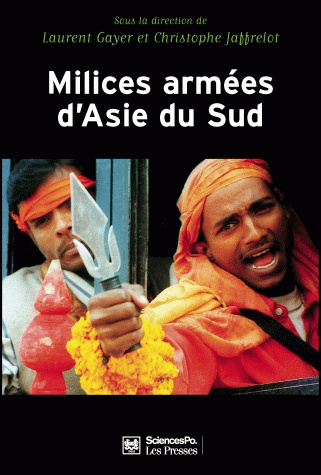Milices armées d'Asie du Sud
Privatisation de la violence et implication des États
First Edition
The number of victims of civil wars, guerrillas or military repressions has not ceased to increase on the Indian subcontinent, despite the absence of interurban wars for the last ten years. These conflicts implicate militias of a paramilitary style, whose ideologies, sociology and strategies are unveiled by this work.
Quite influential in India and in Nepal, Maoist organizations call themselves revolutionaries. But the peoples they aspire to liberate are often composed of the lowest castes and of tribal groups, their guerillas thereby appearing more ethnic than universalist.
They join in with the national emancipation movements whose aim is to obtain political independence for linguistic, religious, or tribal groups. But in Sri Lanka, in Kashmir or in Burma, these groups are also movements of national oppression.
It is already the case for nationalist or religious movements in India, Pakistan and Bangladesh, where Islamic, Nationalist Hindu, or Sikh militias exert a brutal control over their communities, which are in the middle of a veritable police culture.
Militias and states foster complex relations. Sometimes they become veritable states within the State, the militias equally institutionalized by public powers for relaying their authority on the local level.
Laurent Gayer is a Researcher at the CSH (New Delhi Center of Human Sciences), and Associate Researcher at CEIAS (Center of Indian and South Asian Studies).
Christophe Jaffrelot is Director of Research at CNRS and Director of the CERI (Center of International Studies and Research) at Sciences Po.
Contributors to this work: Mariam Abou Zahab, Amélie Blom, Gilles Boquérat, Jérémie Codron, Renaud Egreteau, Nicolas Jaoul, Chris Smith.
Specifications
- Publisher
- Presses de Sciences Po
- Author
- Laurent Gayer, Christophe Jaffrelot,
- Collection
- Académique
- Language
- French
- Tags
- , , ,
- Publisher Category
- > International > Asia
- Publisher Category
- > International
- Publisher Category
- > International field
- BISAC Subject Heading
- POL000000 POLITICAL SCIENCE
- Onix Audience Codes
- 06 Professional and scholarly
- CLIL (Version 2013-2019)
- 3283 SCIENCES POLITIQUES
- Title First Published
- 13 May 2008
- Subject Scheme Identifier Code
- Thema subject category: Politics and government
Paperback
- Publication Date
- 13 May 2008
- ISBN-13
- 978-2-7246-1002-4
- Extent
- Main content page count : 304
- Code
- 978-2-7246-1002-4
- Weight
- 388 grams
- List Price
- 24.50 €
- ONIX XML
- Version 2.1, Version 3
ePub
- Publication Date
- 13 May 2008
- ISBN-13
- 9782724687224
- Product Content
- Text (eye-readable)
- Extent
- Main content page count : 304
- Code
- 9782724687224
- Technical Protection ebook
- Adobe DRM
- ONIX XML
- Version 2.1, Version 3
Google Book Preview
Contents
I - LE PHÉNOMÈNE MAOISTE
Chapitre 1 / LES NAXALISTES DU BIHAR, ENTRE LES ARMES ET LES URNES
Nicolas Jaoul
• Naxalbari et le communisme indien
• L’enracinement du naxalisme au Bihar
• Une répression étatique biaisée et contre-productive
• Naxalistes vs. propriétaires : la spirale de la violence
• La violence intra-naxaliste et ses enseignements
• Quel radicalisme de masse dans un contexte violent ?
• Conclusion
• Bibliographie
Chapitre 2 / MAOISME ET FAIT ETHNIQUE DANS LA GUERRE DU PEUPLE NÉPALAISE
Gilles Boquérat
• Ramifications et analogies transfrontalières
• La montée en puissance du fait ethnique
• Le discours et la pratique maoïstes
• L’implication des organisations ethniques
• Conclusion
• Bibliographie
Chapitre 3 / LES LTTE, MOUVEMENT DE LIBÉRATION ET D’OPPRESSION NATIONALE
Chris Smith
• Les politiques de l’État postcolonial et la réponse des Tamouls
• Escalade militaire et internationalisation du conflit
• L’accord de cessez-le-feu
• La reprise des hostilités
• La stratégie des LTTE
• Un État dans l’État
• Le réseau transnational d’approvisionnement en armes des LTTE
• Bibliographie
Chapitre 4 / LES MILICES DE BIRMANIE, ENTRE INSURRECTIONS ET MAINTIEN DE L’ORDRE
Renaud Egreteau
• Les mouvements ethniques insurgés, dernières oppositions armées à la junte birmane
• Les milices ethniques signataires de cessez-le-feu, entre vassalisation et formation de contre-États
• Les milices progouvernementales, instruments politiques et sociaux du régime militaire birman
• Conclusion
• Bibliographie
I I I - LES MOUVEMENTS POLITICO-RELIGIEUX, RELAIS DU POUVOIR D’ÉTAT ?
Chapitre 5 / LE HIZB-UL-MUJAHIDIN DU CACHEMIRE, IMAGINAIRES MILICIENS ET CLIENTÉLISME
Amélie Blom
• L’enfant illégitime du « mouvement islamique » et de l’armée pakistanaise
• Une force auxiliaire
• Les forces vives : profil sociologique
• L’univers de sens du Hizb ul-Mujahidin
• L’hypothèse clientéliste
• Conclusion
• Bibliographie
Chapitre 7 / LES MILICES ISLAMISTES DU BANGLADESH, SYMPTOˆ MES D’UN ÉTAT FAIBLE ?
Jérémie Codron
• L’islamisme radical : un nouveau type de violence politique ?
• Du mouvement étudiant aux groupes jihadistes
• Le gouvernement et les partis, entre laisser-faire et instrumentalisation
• Conclusion
• Bibliographie
Chapitre 8 / LES BRIGADES DE L’HINDUTVA ET LA POLICE CULTURELLE
Christophe Jaffrelot
• La démonstration de force et la persuasion, stratégies privilégiées du RSS
• Le Bajrang Dal ou la violence sous-traitée
• Conclusion
• Bibliographie
Chapitre 9 / LES MILICES DU KHALISTAN, SERVITEURS ET USAGERS DE L’ÉTAT
Laurent Gayer
• Les « transactions collusives » entre les milices religieuses sikhes et l’État indien
• Des collusions diplomatiques : les relations entre l’État pakistanais et le mouvement insurgé sikh
• Après la collusion : resectorisation et reconversions des insurgés sikhs
• Conclusion
• Bibliographie

